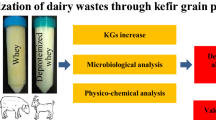Abstract
Controlled fermentation of maize was carried out using six strains of Lactobacillus fermentum and one strain of yeast, Saccharomyces cerevisiae, isolated from traditionally fermented maize dough as starter cultures for inoculum enrichement. The fermentations were monitored by pH, acidity, microbiological analysis and taste panel evaluation of two products, kenkey and koko, prepared from the fermented doughs. The strains of L. fermentum used as starter culture dominated the microflora during fermentation and in most inoculated doughs the required pH was attained by 24 h instead of 48 h of dough fermentation. Higher contents of lactic acid bacteria and yeasts were observed in inoculated doughs at the initial stages of fermentation but the spontaneously fermented doughs attained similar lactic acid bacteria and yeasts counts by 24 h of dough fermentation. The organoleptic quality of kenkey and koko prepared from doughs fermented with starter culture for 48 h was not significantly different from the traditional products. Kenkey prepared from doughs fermented for 24 h with starter culture were found to be unacceptable by the taste panel although similarly produced koko was acceptable.
Similar content being viewed by others
References
AkinreleI.A. 1970 Fermentation studies on maize during the preparation of a traditional African starch-cake food. Journal of Science/Food and Agriculture 21, 619–625.
BanigoE.O.I. & MullerH.G. 1972 Carboxylic acid patterns in Ogi fermentation. Journal of Science Food and Agriculture. 23, 101–111.
Bediako-AmoaB. & AustinF.A. 1976 Investigation of the aflata process in kenkey manufacture. Ghana Journal of Agric Science 9, 59–61.
FieldsM.L., HamadA.M. & SmithD.K. 1981 Natural lactic acid fermentation of corn meal. Journal of Food Science 46, 900–902.
HalmM., LillieA., SorensenA.K. & JakobsenM. 1993 Microbiological and aromatic characteristics of fermented maize doughs for kenkey production in Ghana. International Journal of Food Microbiology, 19, 135–143.
HamadS.H., BöckerG., VogleR.F. & HammesP. 1992 Microbiological and chemical analysis of fermented sorghum dough for Kisra production. Applied Microbiology and Biotechnology 37, 727–731.
Hounhouigan, D.J. 1994 Use of starter cultures of lactobacilli and yeasts in the fermentation of mawè porridge. In Fermentation of maize (Zea mays L.) meal for mawè production in Bénin. Physical, chemical and microbiological aspects. PhD Thesis. Agricultural University of Wageningen, The Netherlands.
HounhouiganD.J., JansenJ.M.M., NoutM. J. R., NagoC.M. & RomboutsF.M. 1992 Production and quality of maize-based fermented dough in Bénin urban area. In Proceedings of the Regional Workshop on Traditional African Foods: Quality and Nutrition (25–29 November 1991), eds WestbyA. & ReillyP.J.A. pp. 9–18. Stockholm: International Foundation for Science.
HughR. & LeifsonE. 1953 The taxonomic significance of fermentative versus oxidative metabolism of carbohydrates by various Gram negative bacteria. Journal of Bacteriology 66, 24–36.
JespersenL., HalmM., KpodoK. & JakobsenM. 1994 Significance of yeasts and moulds occurring in maize dough fermentation for ‘kenkey’ production. International Journal of Food Microbiology 24, 239–248.
KandlerO. & WeissN. 1986 Regular, nonsporing Gram-positive rods. In Bergey's Manual of Systematic Bacteriology, Volume 2, eds SneathP.H.A., MairN.S., SharpeM.E. & HoltJ.G. pp. 1208–1234. Baltimore: Williams and Wilkins.
MbuguaS.K. & NjengaJ. 1992 The antimicrobial activity of fermented uji. Ecology of Food and Nutrition 28, 191–198.
MensahP., TomkinsA.M., PrasarB.S. & HarrisonT.J. 1991 Antimicrobial effect of fermented Ghanaian maize dough. Journal of Applied Bacteriology 70, 203–210.
NyakoK. O. & DansoK.O. 1992 Role of added yeast in the acceptability of naturally fermented corn dough. In Proceedings of Regional Workshop on Traditional African Foods: Quality and Nutrition (25–29 November 1991), eds WestbyA. & ReillyP.J.A. pp. 19–21. Stockholm: International Foundation for Science.
OlsenA., HalmM. & JakobsenM. 1995 The antimicrobial activity of lactic acid bacteria from fermented maize (kenkey) and their interactions during fermentation. Journal of Applied Bacteriology 79, 506–512.
PlaharW.A. & LeungK. 1982 Effect of moisture content on the developement of carboxylic acids in traditional maize dough fermentation. Journal of Science and Agriculture 33, 555–558.
Sefa-DedehS. 1993 Traditional food technology. In Encyclopedia of Food Technology and Nutrition ed. MacraeR., RobinsonR. & SadlerM. pp. 4600–4606. New York: Academic Press.
SimangoC. & RukureH. (1992) Survival of bacterial enteric pathogens in traditional fermented foods. Journal of Applied Bacteriology 73, 37–40.
SteelR.D.G. & TorrieJ.H. (1980) Principles and Procedures of Statistics: A Biometrical Approach, 2nd edn. New York: McGraw-Hill Inc.
Additional information
The authors are with the Food Research Institute, Council for Scientific and Industrial Research, P.O Box M 20. Accra, Ghana.
Rights and permissions
About this article
Cite this article
Halm, M., Osei-Yaw, A., Hayford, A. et al. Experiences with the use of a starter culture in the fermentation of maize for ‘kenkey’ production in Ghana. World J Microbiol Biotechnol 12, 531–536 (1996). https://doi.org/10.1007/BF00419468
Issue Date:
DOI: https://doi.org/10.1007/BF00419468



